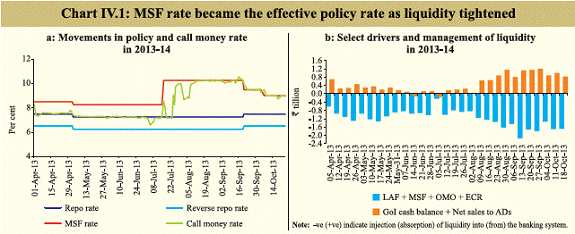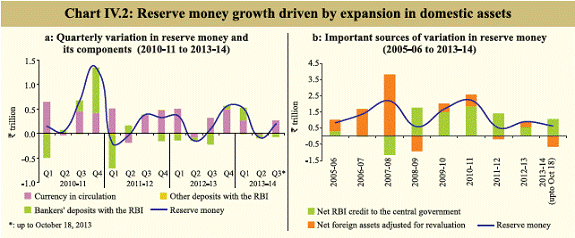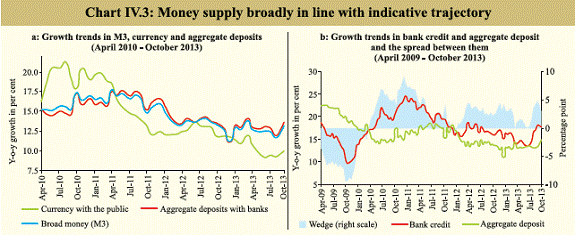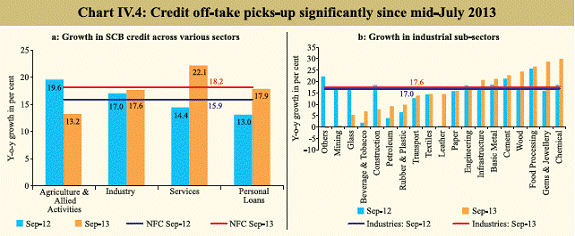IV. Monetary and Liquidity Conditions - આરબીઆઈ - Reserve Bank of India
IV. Monetary and Liquidity Conditions
Monetary and liquidity conditions were tightened through exceptional liquidity measures in order to contain exchange market pressures and dampen volatility in the forex market. The MSF rate which was raised by 200 bps in July 2013, became the effective policy rate. With the ebbing of exchange market pressures, these measures are being rolled back in a calibrated manner. Notwithstanding the tightening, significant primary liquidity injection was done through LAF, MSF and OMO, besides increase in recourse to standing re-finance facilities. Money supply growth has been largely in line with the indicative trajectory. Credit growth has accelerated since mid-July, partly due to the substitution of costlier money market sources of finance by corporates with bank credit. Going forward, with the normalisation of exceptional monetary measures under way, incremental calibration will be shaped by changes in the growth-inflation balance, keeping macroeconomic stability in consideration. The Reserve Bank tightened liquidity during Q2 of 2013-14, raising rupee funding costs to curb forex volatility IV.1 Faced with a sharp depreciation of the rupee consequent on the sudden surge in capital outflows following indications of tapering of the US Fed’s quantitative easing programme, the Reserve Bank hiked shortterm interest rates and compressed domestic money market liquidity as a first line of defence. The measures taken included a 200 basis points (bps) hike in the marginal standing facility (MSF) rate to 10.25 per cent; a cap on daily LAF borrowing to 0.5 per cent of NDTL of respective banks as against the earlier practice of unlimited access against excess SLR holdings; and a hike in the minimum daily cash reserve ratio (CRR) requirement to 99 per cent from 70 per cent of the requirement. Weekly auctions of cash management bills (CMBs) were also conducted to drain out the liquidity. These measures moved up the call rate to the MSF rate, making the latter the effective policy rate in line with policy intent (Chart IV.1a). IV.2 With tighter liquidity, the average daily liquidity injection under LAF (including MSF) increased from `526 billion in July 2013 to `1,131 billion in September 2013. The increase in government cash balances with the Reserve Bank and advance tax outflows also contributed towards the tightening of liquidity in September 2013. The liquidity tightening measures shifted the entire yield curve upwards with inversion visible at the short-end in line with the policy objective. It also led to a sizeable increase in corporate bond yields and commercial paper (CP) discount rates. In order to prevent liquidity conditions from becoming too tight, which would have excessively impacted financing conditions, the Reserve Bank undertook two OMO purchase auctions in August 2013 injecting primary liquidity of `125 billion (Chart IV.1b). Additional liquidity of `247 billion was also injected on a temporary basis by providing two-day funds to banks through the MSF on Saturday (September 14, 2013) to counter the effect of advance tax outflows. Exceptional liquidity measures being rolled back in a calibrated manner as exchange rate pressures ease IV.3 Taking into account the easing of the exchange rate pressures since September 2013 and evolving macroeconomic conditions, the Reserve Bank in its Mid-Quarter Monetary Policy Review (September 20, 2013) moved towards normalising monetary measures. In order to reduce the costs of funds, it reduced the MSF rate by 75 bps to 9.5 per cent. The minimum daily CRR balance maintained by the banks was reduced to 95 per cent of the requirement from 99 per cent to provide banks with the flexibility to better manage their liquidity situation. However, considering inflation risks, the repo rate was increased by 25 bps to 7.5 per cent. The Reserve Bank also signalled its intention to normalise the conduct and operations of monetary policy and to revert to the LAF repo rate as the operational policy interest rate. IV.4 As stable financial market conditions persisted, the MSF rate was further lowered by 50 bps to 9.0 per cent with effect from October 7, 2013. In continuation of the Reserve Bank’s assurance on adequate liquidity, an OMO purchase auction was conducted on October 7, 2013 injecting liquidity of around `100 billion. As an additional liquidity enhancing measure and for developing the term money market, the Reserve Bank introduced weekly variable rate term repos of 7-day and 14-day tenors for an amount equivalent to 0.25 per cent of the NDTL of the banking system. As a result, total access to funds from the Reserve Bank augmented to 1.25 per cent of NDTL (i.e., about ` 1 trillion) consisting of 0.5 per cent of NDTL under the overnight repo, about 0.5 per cent of NDTL under export credit re-finance (ECR) facility and 0.25 per cent of NDTL under term repo. The banks can also meet any further demand for liquidity through MSF. The first round of 7-day term repo was conducted on October 11, 2013 (`190 billion) followed by 14-day term repo on October 18, 2013 (`195 billion). As a result of these measures, the liquidity situation eased in October 2013. Reserve money growth boosted by primary liquidity injection IV.5 Reserve money growth picked up in recent months to 8 per cent y-o-y as at mid- October, while the same adjusted for CRR changes was around 10 per cent. Liquidity injections through LAF, MSF and OMOs have aided the increase in Reserve Bank’s net credit to the central government. Though net foreign assets (adjusted for revaluation) on the sources side registered a decline during the year, it was more than offset by the increase in the Reserve Bank’s net credit to the centre (Chart IV.2). Broad money growth is in line with trajectory IV.6 Money supply growth hovered around 12.5 per cent y-o-y during H1 of 2012-13, broadly in line with the indicative trajectory of 13 per cent for 2013-14, and is currently at 13.2 per cent (October 4, 2013). Currency expansion that had been lower in H1 of 2013-14 has picked up in October reflecting festive demand (Chart IV.3a). On the sources side, bank credit to the commercial sector has picked-up since middle of Q2 (Table IV.1). Consequently, the wedge between the growth in bank credit and aggregate deposit of scheduled commercial banks (SCBs) widened to about 4 percentage points at the end of Q2 (Chart IV.3b). Credit off-take accelerates with greater recourse to bank finance by corporates IV.7 Non-food credit growth increased from 14.0 per cent y-o-y on July 12, 2013 to 17.9 per cent on October 4, 2013, markedlyhigher than the indicative trajectory of 15 per cent. In part, this trend was supported by corporate firms substituting their market borrowings, especially through CPs, by bank borrowings (Table IV.2). This substitution occurred as money market rates, including discount rates on CPs firmed up and primary market conditions remained subdued.
IV.8 Given the lacklustre domestic environment, banks need to ensure better credit management practices when extending loans, keeping a careful watch on their asset quality. The Reserve Bank’s initiative to collate large common exposures across banks and make available the credit registry data is expected to help mitigate this problem. Credit growth broad-based, uptick across sectors IV.9 Data on sector-wise deployment of gross non-food bank credit of select SCBs indicate a build-up in credit to industries, services and also personal loan category (especially, housing) (Chart IV.4a). Overall industrial credit growth (y-o-y) was at 17.6 per cent in end-September 2013, with sectors such as basic metals, chemicals, infrastructure, cement, gems and jewellery, wood and food processing registering an above industryaverage growth (Chart IV.4b). IV.10 With the Reserve Bank increasing the cost of borrowing under MSF, even while restricting the availability of accom-modation under the LAF repo, the modal deposit rate increased by 20 bps (q-o-q) during Q2 (Table IV.3). This rise was mainly with respect to shortterm aturities of up to 180 days reflecting the tightening of liquidity conditions. Although the modal base rate remained unchanged at 10.25 per cent during Q2, the weighted average lending rate (WALR) on the outstanding bank loans increased marginally by 4 bps (q-o-q) to 12.15 per cent in August 2013. The WALR on fresh rupee loans sanctioned by banks increased sharply by 42 bps to 12.04 per cent in August 2013 from 11.62 per cent in June 2013. Normalisation of exceptional measures underway, changes ahead will be conditioned by high inflation and low growth challenges IV.11 The exceptional liquidity and monetary policy measures taken in the face of unprecedented exchange rate pressures were partially rolled back in the Mid-Quarter Monetary Policy Review on September 20 and further on October 7, 2013. Both these moves have lowered the effective policy rate by 125 bps. The Reserve Bank has also ensured sufficient liquidity in the system through LAF, MSF and OMO over a period of time in line with its assurances. Consequently, base money growth has picked up. Credit growth has also accelerated. With the process of normalisation of monetary measures making headway, monetary policy ahead would depend on how growth-inflation dynamics evolve. Liquidity conditions will have to be maintained at an appropriate level keeping in view the persistence in CPI inflation as also the slack growth conditions. |
||||||||||||||||||||||||||||||||||||||||||||||||||||||||||||||||||||||||||||||||||||||||||||||||||||


























